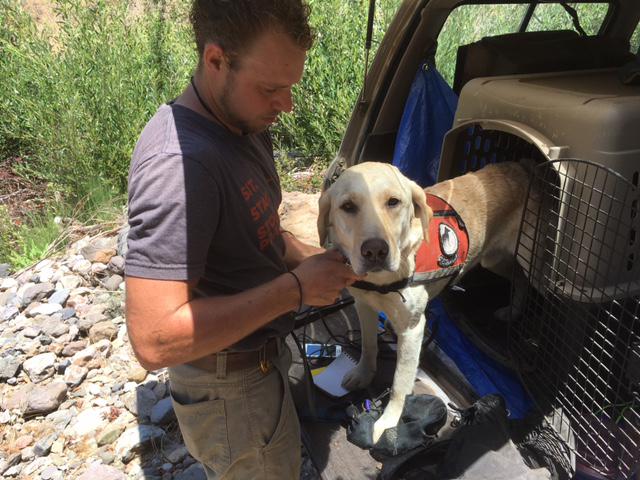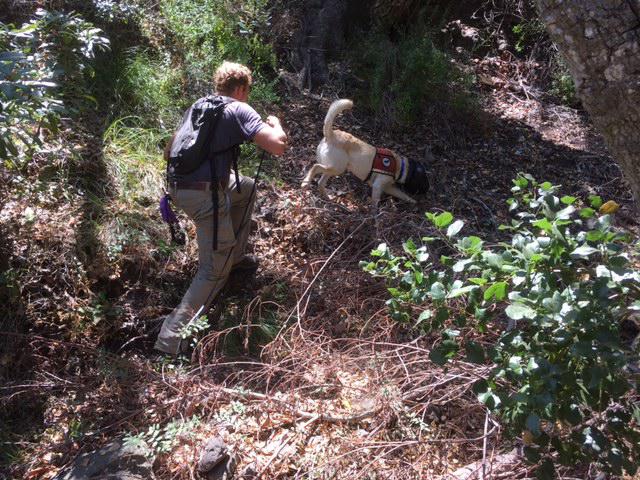Eagles And Foxes, Plants And Ants
4:37 minutes

 This segment is part of The State of Science, a series featuring science stories from public radio stations across the United States. A version of this story, by Lance Orozco, originally appeared on 88.3 KCLU Public Radio at California Lutheran University.
This segment is part of The State of Science, a series featuring science stories from public radio stations across the United States. A version of this story, by Lance Orozco, originally appeared on 88.3 KCLU Public Radio at California Lutheran University.
Tobias is on the job on Santa Cruz Island.
He was once a shelter dog in Montana. But, he’s now an environmental superstar. Tobias is a one of a kind “ant-dog”. He’s the only dog in the world trained to track down a specific invasive species of ant in the wild.
It’s what the three year old yellow lab is doing as he sniffs his way through some brush in a Santa Cruz Island canyon.
The National Park Service and the non-profit group, The Nature Conservancy, which owns part of the island have been trying to restore Santa Cruz Island by removing non-native species. One of the big problems is non-native Argentine ants, which wipe out native ants, and can kill bees, lizards, and even seabird chicks.
Christina Boser is a California Islands Ecologist with The Nature Conservancy. She says it’s believed the ants were accidentally brought to the island years ago with along with some construction materials. She was given the job of trying of finding a way to get rid of the ants, which infested about a thousand acres of the 60,000 acre island. They developed a ten year plan funded by the state, the National Park Service, and the Nature Conservancy.
They created a low level poison bait worker ants would take back to colonies, yet would be safe for the environment. The pesticide was first tested by 2013, and was used over a four year period. Now, in 2017, the Argentine ants appear to be gone But, how do you really tell if the ants are really gone?

That’s where Tobias came into the picture. Boser says they contacted some people in New Zealand, who had trained some dogs to find ants. They then developed a program with a company which trains dogs. Four rescue dogs started the training, but Tobias was the only one to complete it. So, that’s how Tobias ended up on Santa Cruz Island, where he’s spending about three month hunting for the ants.
[Meet the mavericks of the bat world.]
Handler Kai Zimmerman says he and Tobias are truly a team, because the dog needs to be able to show him when he’s found something, and he needs to be able to understand when Tobias thinks he has a hit. They periodically do retraining with some of the ants brought in for the purpose, to insure Tobias stays on track.
Even if the island is declared ant-free following the dog’s search, monitoring efforts with traps will continue for years, with the project funded through 2022. And, don’t worry about the future of Tobias. The ant sniffing dog already has his next job lined up. He, and Zimmerman will head to another of the Channel Islands, San Clemente Island, which is dealing with a 1,300 acre Argentine ant infestation.
Lance Orozco is news director at KCLU in Thousand Oaks, California.
IRA FLATOW: And now it’s time to check in on the state of science.
ANNOUNCER: This is KERA. For WWNO– St. Louis public radio. Iowa public radio news.
IRA FLATOW: Local science stories of national significance. California’s Channel Islands, a cluster of islands off of the Southern California coast, have been compared to the Galapagos, isolated islands with unique ecosystems, home to some species found nowhere else. And five of the islands became a national park in the 1980s. Before that, they were home to ranching and farming and home to the Chumash people for thousands of years before that.
But a cascade of ecological problems threaten the island. Lance Orozco, news director here at KCLU, is with me now to talk about efforts to protect and preserve the ecology there.
Welcome. Good to see you, Lance.
LANCE OROZCO: Well, good to be with you, Ira.
IRA FLATOW: So tell us about the ecological problems, a little bit of the history. This is nothing new, right?
LANCE OROZCO: No it’s really interesting it’s sort of like CSI for biologists here because we had this whole chain reaction of things. But as you mentioned, we had the ranchers moved in, and they brought in cattle and sheep and pigs and other non-native things to the islands.
But what happened was, after World War II, a lot of DDT ended up in the ocean. The DDT ended up in fish. Now the reason this is significant is the bald eagles, which are native to the islands, eat these fish. And it built up to the point in the bald eagles that whenever they would nest, the eggs would crack. So they would basically, they would sit on the eggs, and they would crack.
And the bald eagles came to the point of extinction. So they brought in the bald eagles for a captive breeding program. So that opened another door. Golden eagles, which don’t live in the islands naturally, said hey, this looks like a great place to live because our nemesis is gone now. So golden eagles moved out into the islands.
The golden eagles, when they moved out there, started to eat the feral pigs that were out there and also this rare species of fox. It’s called the island fox. It looks like a cat. It’s a tiny little fox. They’re cute. They’re adorable looking.
And the island fox are very curious about people, but the island fox doesn’t have it in their DNA to be on the alert for the golden eagle. So the golden eagles basically started feasting on them, pushed them to the point of extinction. So you had this whole chain reaction.
Biologists looked at this, and said, OK. We need to grab what island foxes we have left. We need to bring them in for a captive breeding program to try to save them. And so you had this whole cascade of events. And so the biologists had to figure out how these things were interrelated, and they started to fix them.
IRA FLATOW: And it’s fascinating. So what do you mean they started to fix them?
LANCE OROZCO: So what happened was they finally got enough of the bald eagles that they were able to reintroduce them to the islands. Then the golden eagles that had moved into the islands, they did a trapping program. They relocated them to another part of California and into Nevada as well.
And then the island foxes had gotten to the point where they could rerelease them onto the islands, and they’ve just been growing. Tim Coonan, who’s a National Park Service biologist, I’ve talked to him for 20 years about this project. He said maybe in our lifetime we could see the island fox recover. It happened in less than 20 years. It’s remarkable. Biologists around the world are looking at this because humans were able to fix the problem.
IRA FLATOW: But wait, there’s more.
LANCE OROZCO: There is more because there’s other non-native things out there. There’s eucalyptus trees, and there’s ants, specifically Argentine ants, which you find on Santa Cruz Island. They went in, and they said, OK. We’re going to dust for these ants. We’re going to get rid of these ants, but the problem is, Ira, how do you know that you’ve gotten rid of all the ants?
IRA FLATOW: We have a little clip about that.
CHRISTINE BOSER: We think the treatment that we did is very, very effective, to the point that we cannot find any ants with us and our human abilities. We put out over 60,000 lures. We’re at a point where we think we did a really good job on the treatment. We’re bringing out this dog to try to verify our results to ensure that we can say, yup. OK, we’re done. We did the eradication.
LANCE OROZCO: Now, that’s Christina Boser with the Nature Conservancy. So what they did is this group called Working Dogs for Conservation in Montana trained this dog specifically to find Argentine ants, the only dog of its type in the world. It went out. It checked out the islands, and it said Santa Cruz Island is ant-free.
In fact, now, Tobias, I said just checked up on Tobias. He’s now looking for quagga mussels in Glacier National Park. And so he’s moved on, but they were able to show that the island is now ant-free, thanks to the ant dog.
IRA FLATOW: So we have a happy ending.
LANCE OROZCO: We do.
IRA FLATOW: A happy ending to this story. Thank you, Lance. Lance Orozco is a news director here at KCLU in Thousand Oaks, California.
We’re going to take a break. And when we come back, the countdown to the midterms, the midterm elections is on and just a month out. How secure are our ballot boxes? We heard that there had been some interference in the last election. We’ll see how more secure they might be. Stay with us. We’ll be right back after this break.
Copyright © 2018 Science Friday Initiative. All rights reserved. Science Friday transcripts are produced on a tight deadline by 3Play Media. Fidelity to the original aired/published audio or video file might vary, and text might be updated or amended in the future. For the authoritative record of Science Friday’s programming, please visit the original aired/published recording. For terms of use and more information, visit our policies pages at http://www.sciencefriday.com/about/policies/
As Science Friday’s director and senior producer, Charles Bergquist channels the chaos of a live production studio into something sounding like a radio program. Favorite topics include planetary sciences, chemistry, materials, and shiny things with blinking lights.